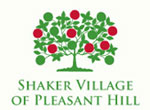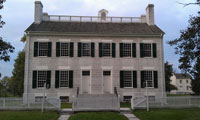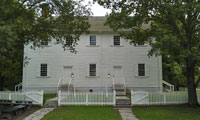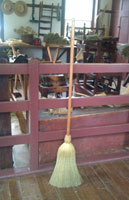| |||
|
Shakers in Kentucky
After the Civil War as the economy moved toward industrialization, like the better known Shaker communities in the Northeast, Pleasant Hill experienced fewer converts. As the community shrank and poor financial decisions were made, the buildings fell into disuse and the land was slowly sold off. The village officially closed in 1910 and the last Pleasant Hill Shaker died in 1923. Overtime many building collapsed while other buildings were re-purposed for a variety of uses including gas station, warehouse, church and individual houses. In 1961, a group of local private citizens had the foresight to realize that Kentucky was losing an important part of its history. They formed a non-profit and undertook fundraising to purchase the remaining buildings and land to restore and preserve them for future generations.
During our tours of the buildings, we learned so much about the Shakers. The United Society of Believers in Christ’s Second Appearing began as a dissent group in England in the mid-1770s. Commonly known as Shakers, they first came to America in 1774 settling in New England. The Shakers had four fundamental tenets: confession of sin, celibacy, separation from the world, and holding all things in common. However, it wasn’t until the Pleasant Hill community was established that they wrote down any of their principals. When they finally did, it took 600 pages and many years to get agreement. Many of us think of the “tree of life” as synonymous with Shaker. Ann Lee (aka “Mother Lee”) was an early believer and evangelist for the Shakers. She was incarcerated for her beliefs and had food/drink withheld for 14 days. After she was released, she had a vision of the tree of life which became a symbol that today continues to represent the Shakers. Music and dance were always a major component prayer for the Shakers. Initially, music and dance had no prescribed words or steps (hence the name “Shakers” was applied by those that watch the services). However, as the communities grew and times changed, the Shakers did in fact choreograph line, circle and square dances. They also wrote over 20,000 songs. While at the Village, we were privy to hear just a few of them including the Shaker’s #1 hit, a song you are likely to have heard: 'Tis the Gift to be Simple.
The Pleasant Hill community used a lot of blue and red paint on their buildings and items. We learned that the “Shaker” blue paint was made with linseed oil and indigo. Since they had to purchase the indigo, it was considered an “expensive” paint and was used in places that would get less wear. The “blood” red paint was used on base boards, floors and other high-wear areas since it was considered a “free” paint – made from the blood of slaughtered animals and other materials they produced themselves. Today, we are disgusted with the notion of using animal blood, but it is very much in keeping with the Shaker philosophy of minimal waste. Search for Shaker on Dig Antiques and see some wonderful examples!
|
|
Updated Shops Area on Dig Antiques Based on feedback, we made some updates to the Shops area on Dig Antiques that we think you'll enjoy. Within a Shop, you can now enlarge multiple images at one time and move them around your window. This will let you view multiple images and also the text that describes the images. Also, moving from Shop to Shop is now easier. When in a Shop, just click on the Shops menu, you'll see a list of all the Shops - just click on the Shop you want to view next and be taken right to it. Speaking of Shops, we have another new Shop this month. Please join us in welcoming Teri Dziadul and Daughter. Learn how you can open your own Shop on Dig Antiques. Lastly, are you a dealer looking for ways to drive more traffic to your website? If so, please consider becoming a sponsor and advertising on Dig Antiques. We have over 13,000 searches a month on Dig Antiques. Do you dig it? Sincerely, |
|
Search Showcase Have you been digging for antiques recently? |
|
August 2011 Top Searches Below is a summary of the twenty most popular search phrases last month.
1. bread board |
|
Sponsors |
|
Thank you to the following current advertisers for their support of Dig Antiques:
Ames Gallery If you are interested in supporting Dig Antiques through advertising, please click here. |
|
Contact Us |
|
For general information:
Website: www.digantiques.com |
|
© 2011 Dig Antiques. All rights reserved. |


 Today, there are 34 restored buildings and 3,000 acres (of the original 5,000) that are part of Shaker Village (or “Shakertown” as the locals still call it.) The Center Family Dwelling (right) is over 6,000 square feet made from limestone. It is still the second largest stone building in Kentucky – the largest is the old state capital.
Today, there are 34 restored buildings and 3,000 acres (of the original 5,000) that are part of Shaker Village (or “Shakertown” as the locals still call it.) The Center Family Dwelling (right) is over 6,000 square feet made from limestone. It is still the second largest stone building in Kentucky – the largest is the old state capital.  You can tour the Meeting House (left) and see how the truss system design allows this large building to have no posts. During the day the Village buildings are open for tours, dining, hiking and even horseback riding on the many miles of trails. A unique part of this community, an
You can tour the Meeting House (left) and see how the truss system design allows this large building to have no posts. During the day the Village buildings are open for tours, dining, hiking and even horseback riding on the many miles of trails. A unique part of this community, an  Shaker furniture was built for function. They didn’t believe in decoration – other than the natural beauty that God created in the wood. Unlike the New England communities, Shaker furniture created in Pleasant Hill had turned legs. Since they did not generally create furniture for re-sale, what survives today was for internal use in the community. On the other hand, they were known far and wide for their brooms. In 1869, they produced and sold 74,400 brooms – a staggering number considering they produced everything they needed to make the brooms in the community. A good Shaker broom would last for a long time – weighing 4 lbs and thick enough to would stand up on their own. A straw pulled (or lost) from the broom would be used as a cake tester and other straw that broke off would be put together as a pot scrubber.
Shaker furniture was built for function. They didn’t believe in decoration – other than the natural beauty that God created in the wood. Unlike the New England communities, Shaker furniture created in Pleasant Hill had turned legs. Since they did not generally create furniture for re-sale, what survives today was for internal use in the community. On the other hand, they were known far and wide for their brooms. In 1869, they produced and sold 74,400 brooms – a staggering number considering they produced everything they needed to make the brooms in the community. A good Shaker broom would last for a long time – weighing 4 lbs and thick enough to would stand up on their own. A straw pulled (or lost) from the broom would be used as a cake tester and other straw that broke off would be put together as a pot scrubber.